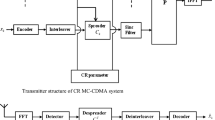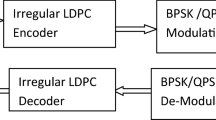Abstract
In this paper, a random Low-Density Parity-Check (LDPC) code is proposed for Noncontiguous Orthogonal Frequency Division Multiplexing (NC-OFDM) Cognitive Radio (CR) systems. Unlike other encoding schemes which achieve a system code rate of only 1/4 when half of the subcarriers are active, the proposed scheme achieves a system code rate of 1/2. The LDPC code is used to enhance the data transmission rate. A new channel model comprised of a binary erasure channel concatenated with an uncorrelated fading channel and an AWGN channel is adopted for NC-OFDM CR systems. Moreover, the adopted channel model is employed with density evolution algorithm to obtain good degree distribution pairs for the LDPC code. Thereafter, a modified shortest-path algorithm is used to construct the parity-check matrix for the LDPC code. Simulation results show that the proposed LDPC code performs well in terms of both error rate and data transmission rate.









Similar content being viewed by others
References
Mitola, J., & Maguire, G. Q. (1999). Cognitive radio: Making software radios more personal. IEEE Transactions on Personal Communications, 6(4), 13–18.
Haykin, S. (2005). Cognitive radio: Brain-empowered wireless communications. IEEE Journal on Selected Areas in Communications, 23(2), 201–220.
Poston, J. D., & Horne, W. D. (2005). Discontiguous OFDM considerations for dynamic spectrum access in idle TV channels. In Proceedings of IEEE DySPAN.
Weiss, T., & Jondral, F. (2004). Spectrum pooling: An innovative strategy for enhancement of spectrum efficiency. IEEE Communications Magazine, 42(3), S8–S14.
Qu, D. M., Ding, J., Jiang, T., & Sun, X. J. (2011). Detection of non-contiguous OFDM symbols for cognitive radio systems without out-of-band spectrum synchronization. IEEE Transactions on Wireless Communications, 10(2), 693–701.
Gallager, R. G. (1962). Low density parity check codes. IIRE Transactions on Information Theory, IT–8(1), 21–28.
MacKay, D. J. C., & Neal, R. M. (1996). Near-Shannon-limit performance of low density parity check codes. Electronics Letters, 32, 1645–1646.
Richardson, T., Shokrollahi, M. A., & Urbanke, R. (2001). Design of capacity approaching irregular low-density parity-check codes. IEEE Transactions on Information Theory, 47(2), 619–637.
Hu, X.-Y., Eleftheriou, E., & Arnold, D. M. (2005). Regular and irregular progressive edge-growth Tanner graphs. IEEE Transactions on Information Theory, 51(1), 386–398.
Ha, J., & McLaughlin, S. W. (2003). Low-density parity-check codes over guassian channels with erasures. IEEE Transactions on Information Theory, 49(7), 1801–1809.
Hou, J., Siegel, P. H., & Milstein, L. B. (2001). Performance analysis and code optimization of low density parity-check codes on Rayleigh fading channels. IEEE Journal on Selected Areas in Communications, 19(5), 924–934.
Jafar, S. A., & Srinivasa, S. (2007). Capacity limits of cognitive radio with distributed and dynamic spectral activity. IEEE IEEE Journal on Selected Areas in Communications, 25(3), 529–537.
MacKay, D., Wilson, S., & Davey, M. (1999). Comparison of constructions of irregular Gallager codes. IEEE Transactions on Communications, 47, 1449–1454.
Cormen, T. H., Leiserson, C. E., Rivest, R. L., & Stein, C. (2001). Introduction to algorithms, second edition. MIT Press and McGraw-Hill, ISBN 0-262-03293-7.
Campello, J., & Modha, D. (2001). Extended bit-filling and LDPC code design. In Proceedings of IEEE Globecom, (San Antonio, TX), pp. 985–989.
Campello, J., Modha, D., & Rajagopalan, S. (2001). Designing LDPC codes using bit-filling. In Proceedings of IEEE international conference on communication (ICC), (Helsinki, Finland), pp. 5559.
MacKay, D. J. C. (2014). Encyclopedia of sparse graph codes, last visited. [Online] Available: http://www.inference.phy.cam.ac.uk/mackay/codes/data.html.
Author information
Authors and Affiliations
Corresponding author
Rights and permissions
About this article
Cite this article
Shebl, S., Shokair, M. & Gomaa, A. Novel Construction and Optimization of LDPC Codes for NC-OFDM Cognitive Radio Systems. Wireless Pers Commun 79, 69–83 (2014). https://doi.org/10.1007/s11277-014-1841-9
Published:
Issue Date:
DOI: https://doi.org/10.1007/s11277-014-1841-9




